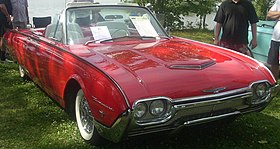Ford Thunderbird (third generation)
| Third generation Ford Thunderbird | |
|---|---|
 |
|
| Overview | |
| Manufacturer | Ford |
| Production | 1961–1963 |
| Assembly | Wixom, Michigan |
| Body and chassis | |
| Body style | 2-door hardtop coupe 2-door convertible |
| Layout | FR layout |
| Powertrain | |
| Engine | 390 cu in (6.4 L) FE V8 |
| Transmission | Cruise-O Matic MX automatic |
| Dimensions | |
| Wheelbase | 113 in (2,870 mm) |
| Length | 205 in (5,207 mm) |
| Width | 75.9 in (1,928 mm) |
| Chronology | |
| Predecessor | Ford Thunderbird (second generation) |
| Successor | Ford Thunderbird (fourth generation) |
The third generation of the Ford Thunderbird is a personal luxury car produced by Ford for the 1961 to 1963 model years. It featured new and much sleeker styling than the second generation models. Sales were strong, if not quite up to record-breaking 1960, at 73,051 including 10,516 convertibles. A new, larger 390 cu in (6.4 L) FE-series V8 was the only engine available (in 1961). The Thunderbird was 1961's Indianapolis 500 pace car, and featured prominently in US President John F. Kennedy's inaugural parade, probably aided by the appointment of Ford executive Robert McNamara as Secretary of Defense. It shared some styling cues with the much smaller European Ford Corsair.
The Thunderbird for 1961 introduced several firsts for the automotive market. The most distinctive feature of the 1961 to 1963 Thunderbirds was the highly touted 'Swing Away' steering wheel. With the transmission in the park position the steering wheel would slide approximately 18 inches (460 mm) to the right allowing the driver to exit the vehicle easily. Other innovations include a floating rear view mirror. Common on all autos produced today, this feature was first found on 1961 Thunderbirds. Depending on variable options Thunderbirds for 1961 could be purchased with options like air conditioning, power windows, power seats, AM radio, fender skirts and white wall tires. Several standard features, like power steering and power brakes, back up lights and bucket seats were costly options on most other autos.
1962 saw strong production figures of 78,011 (including 9,884 convertibles) and the introduction of the Thunderbird Sports Roadster. The Sports Roadster was a limited production version of the convertible which added 48 spoke Kelsey-Hayes designed wire wheels, special badges to the front fenders and a passenger side grab bar to the front dashboard. The most striking addition to the Sports Roadster was a fiberglass tonneau cover which covered the back seat of the car and created a two seater appearance. 1,427 Sports Roadsters were produced in 1962, including 120 models with the special M Code option noted below. Early models suffered from problems related to their specially-designed wire wheels. The problem was quickly corrected when Elvis Presley was involved in an accident in which one of the Kelsey-Hayes wheels collapsed during hard turning.
...
Wikipedia
